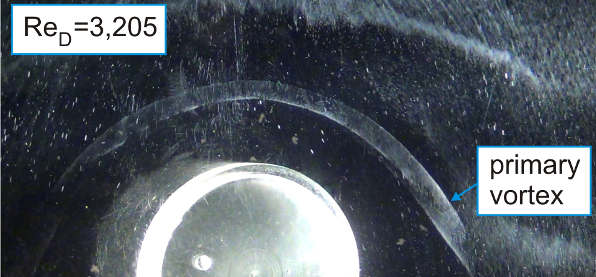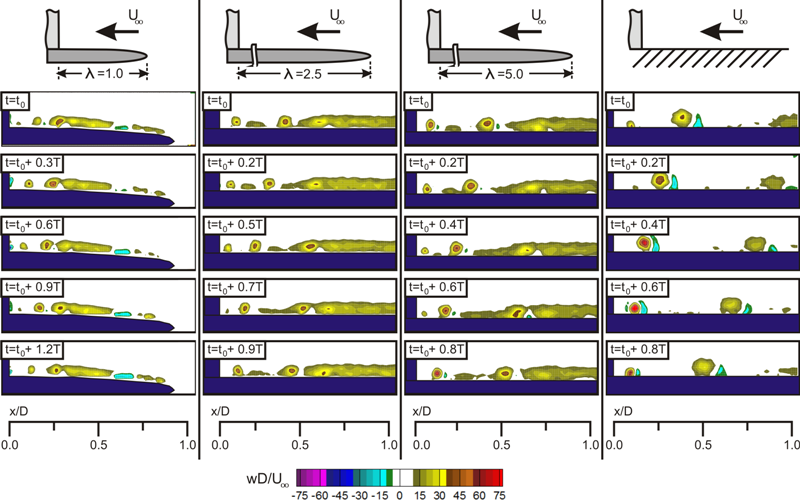Junction Flows Horseshoe Vortex Dynamics
When a boundary layer flow (either laminar or turbulent) encounters an
obstacle projecting from that surface, some distance upstream of the
obstacle the boundary layer separates as a result of the adverse
pressure gradient, and rolls up to form three-dimensional complex
vortices. These vortices have the characteristic shape of a horseshoe,
such that the legs of the vortices extend downstream, to both sides of
the body. Figure below is obtained through hydrogen bubble
visualization and shows the shape of the horseshoe vortex forming
upstream of a cylinder-plate juction.

Figure 1:
Laminar horseshoe vortex forming upstream of the cylinder-plate
junction. Visualization is achieved through hydrogen bubble technique
in our water channel.
Horseshoe vortices form in many real
scenarios, such as at wing-body junctions in airplanes, turbine
blade-hub junctions, cooling flow past computer chips, and so on.
Horseshoe vortices often have large effects on flow properties in the
junction region, such as the local heat transfer, skin friction, and
noise. For example, at the junction of an airplane wing with the
fuselage, formation of horseshoe vortices and associated complex flow
can dramatically impair the performance of the aircraft. It can result
in an increase in local skin friction, noise, and drag. The drag
induced by the wing-fuselage junction is estimated to be 10% of the
total drag in modern civil airplanes. Hence, the design of wing-body
junctions or empennage-fuselage junctions is important for aircraft
makers. In the case of a bridge or pier suport, for instance, owing to
the horseshoe vortices, local skin friction can cause severe erosion at
the junction. Another situation, where horseshoe vortices have dramatic
effects, is a turbine blade-hub junction. In this case, horseshoe
vortices can affect increase the local heat transfer rates and thereby
cause thermal gradients in the blade.
The present investigation consists of two phases:
In
the first phase, the project investigates how the characteristics of
the oncoming bounday layer affects the unsteady dynamics of horseshoe
vortex systems. To this end, an experimental investigation is conducted
involving cylinder-channel floor and cylinder-end plate junctions. By
changing the leading-edge geometry of the endplates and the cylinder
position from the tip of the endplate, effects both laminar and
turbulent aproach flows with various characteristics are studied.
Below, in Figure 2, one excerpt from many of our interesting findings
is given. A journal publications is at the submission stage on this
phase of the investigation. Interested fellows: stay tuned for further
information.

Figure 2:
Iso-contours of vorticity: Snapshots of the junction flow at the
upstream of the symmetry plane are shown for cylinder-endplate junction
in the first three columns and for the cylinder-channel floor junction
in the last column. An increase in the thickness of the laminar
boundary layer results in a gradual decrease in the formation frequency
of horseshoe vortices. This effect can be distinguished visually by the
increasing distance between the primary and secondary horseshoe vortex
in this figure.
In the second phase, to reduce the adverse
effects of the unsteady horseshoe vortex flows, modifications to the
geometry of the wing/body will be examined. The project will
specifically investigate the effects of adding simple flow control
devices, such as fillets, leading edge adjustments, and fairings, on
idealized wing junctions.